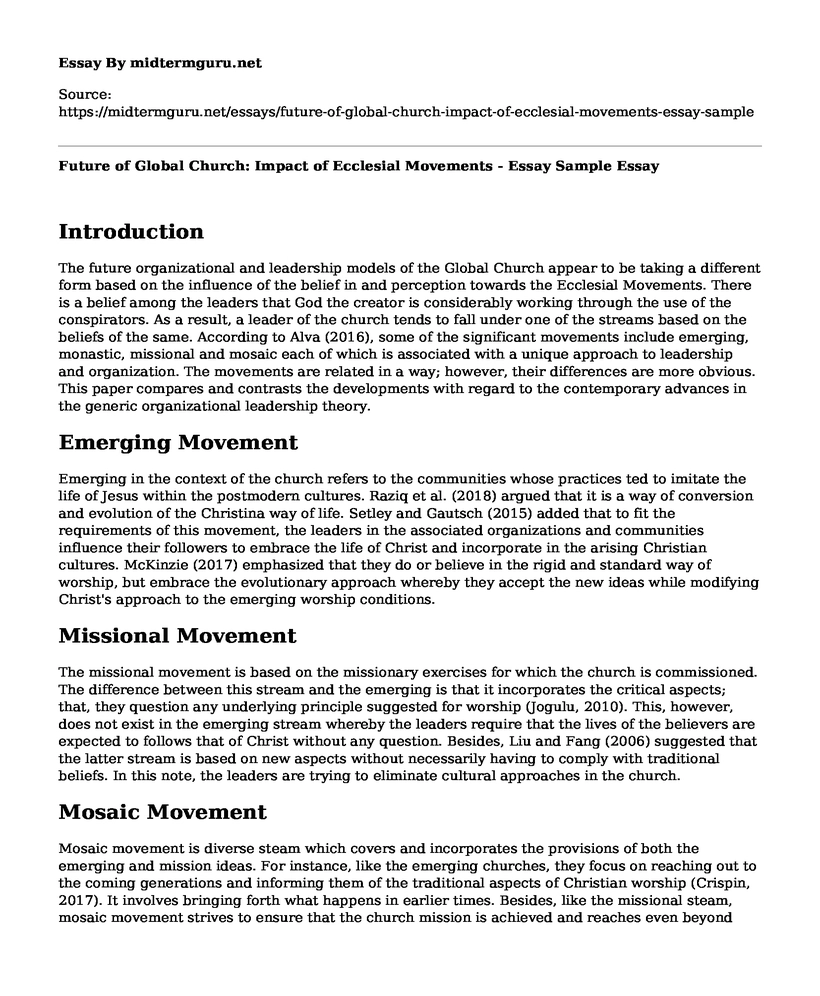Introduction
The future organizational and leadership models of the Global Church appear to be taking a different form based on the influence of the belief in and perception towards the Ecclesial Movements. There is a belief among the leaders that God the creator is considerably working through the use of the conspirators. As a result, a leader of the church tends to fall under one of the streams based on the beliefs of the same. According to Alva (2016), some of the significant movements include emerging, monastic, missional and mosaic each of which is associated with a unique approach to leadership and organization. The movements are related in a way; however, their differences are more obvious. This paper compares and contrasts the developments with regard to the contemporary advances in the generic organizational leadership theory.
Emerging Movement
Emerging in the context of the church refers to the communities whose practices ted to imitate the life of Jesus within the postmodern cultures. Raziq et al. (2018) argued that it is a way of conversion and evolution of the Christina way of life. Setley and Gautsch (2015) added that to fit the requirements of this movement, the leaders in the associated organizations and communities influence their followers to embrace the life of Christ and incorporate in the arising Christian cultures. McKinzie (2017) emphasized that they do or believe in the rigid and standard way of worship, but embrace the evolutionary approach whereby they accept the new ideas while modifying Christ's approach to the emerging worship conditions.
Missional Movement
The missional movement is based on the missionary exercises for which the church is commissioned. The difference between this stream and the emerging is that it incorporates the critical aspects; that, they question any underlying principle suggested for worship (Jogulu, 2010). This, however, does not exist in the emerging stream whereby the leaders require that the lives of the believers are expected to follows that of Christ without any question. Besides, Liu and Fang (2006) suggested that the latter stream is based on new aspects without necessarily having to comply with traditional beliefs. In this note, the leaders are trying to eliminate cultural approaches in the church.
Mosaic Movement
Mosaic movement is diverse steam which covers and incorporates the provisions of both the emerging and mission ideas. For instance, like the emerging churches, they focus on reaching out to the coming generations and informing them of the traditional aspects of Christian worship (Crispin, 2017). It involves bringing forth what happens in earlier times. Besides, like the missional steam, mosaic movement strives to ensure that the church mission is achieved and reaches even beyond their definite congregations (Curtis, 2018). It, therefore, tries to achieve an inclusive approach in the movement.
Monastic Movement
The fourth movement is the monastic movement which is significantly different from the rest. Elkington (2011) and Michaelson et al. (2014) argued that it is based on the belief that earlier ideas should not be accepted without adequate evidence. The leaders in the associated organizations believe in the idea that questioning a notion is the most important approach in contemporary society. Alva (2016) felt that they question why Christians should undertake discipleship exercises and why they have to accomplish missionary activities. This makes it different from the earlier three streams.
Conclusion
The four movements are related in that they are based on the Christian foundation. However, they exhibit considerable differences amongst themselves since there are individual form m of beliefs which inform leadership and the behaviours expected on the rest of the followers. Moreover, the leaders in each believe in themselves and rarely feel validity in the other stream. Nevertheless, all of them have a characteristic of fluidity which makes them converge into one another based on the common beliefs regarding Jesus Christ.
References
Alva, R. (2016). Bridging the Gap between Orthodoxy and Orthopraxis: The Catholic Church's Concern for Migrants. Transformation: An International Journal Of Holistic Mission Studies, 34(1), 1-11. DOI: 10.1177/0265378815602041
Crispin, G. (2017). A Theology of Accommodation as a Resource for Integrating Youth and Children into Intergenerational Church. Christian Education Journal: Research On Educational Ministry, 14(1), 7-22. DOI: 10.1177/073989131701400102
Curtis, G. (2018). Connecting influence tactics with full-range leadership styles. Leadership & Organization Development Journal, 39(1), 2-13. DOI: 10.1108/lodj-09-2016-0221
Elkington, R. (2011). A Missional Church Model. SAGE Open, 1(3), 215824401142808. DOI: 10.1177/2158244011428086
Jogulu, U. (2010). Culturallylinked leadership styles. Leadership & Organization Development Journal, 31(8), 705-719. DOI: 10.1108/01437731011094766
Liu, A., & Fang, Z. (2006). A powerbased leadership approach to project management. Construction Management And Economics, 24(5), 497-507. DOI: 10.1080/01446190600567944
McKinzie, G. (2017). Missional Hermeneutics as Theological Interpretation. Journal Of Theological Interpretation, 11(2). Retrieved from https://www.jstor.org/stable/10.5325/jtheointe.11.2.0157?seq=1#page_scan_tab_contents
Michaelson, V., Pickett, W., Robinson, P., & Cameron, L. (2014). Participation in Church or Religious Groups and Its Association with Health. Part 2: A Qualitative, Canadian Study. Journal Of Religion And Health, 54(3), 1118-1133. DOI: 10.1007/s10943-014-9961-9
Raziq, M., Borini, F., Malik, O., Ahmad, M., & Shabaz, M. (2018). Leadership styles, goal clarity, and project success. Leadership & Organization Development Journal, 39(2), 309-323. DOI: 10.1108/lodj-07-2017-0212
Setley, D., & Gautsch, D. (2015). Leadership and the church: The impact of shifting leadership constructs. International Journal Of Business And Social Research, 5(12). Retrieved from https://thejournalofbusiness.org/index.php/site/article/download/887/576
Cite this page
Future of Global Church: Impact of Ecclesial Movements - Essay Sample. (2023, Jan 23). Retrieved from https://midtermguru.com/essays/future-of-global-church-impact-of-ecclesial-movements-essay-sample
If you are the original author of this essay and no longer wish to have it published on the midtermguru.com website, please click below to request its removal:
- Ford and Taylorism Theories of Productivity - Paper Example
- Divine Command Theory - Religion Essay Example
- Essay Sample: Career Development Concerns Ones Whole Life Rather Than Ones Occupation
- The Effect of Business Ethics in Improving the Productivity in a Business Organization - Paper Example
- Research Paper on Teamwork
- Analysis of Cross-Cultural Leadership Practices - Essay Sample
- Jesus in Islam: Who He Was and His Mission - Essay Sample







